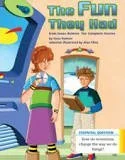EDU Trending: Education Chaos.
The definition of chaos: complete disorder and confusion.
Some synonyms of chaos: pandemonium, bedlam, turmoil, lawlessness, uproar, and anarchy.
An example of chaos: the current state of education in the United States.
The education of our children is the number one topic and concern for parents everywhere. Here at home, the subject has been turbo-charged since the pandemic with a variety of special interest groups and states weighing in on.
… what schools should/should not be, what curriculum should/should not be taught, the learning gap, who sets curriculum, defining truth, honoring D.E.I. (diversity, equity, and inclusion), the importance of social/emotional well-being, passing laws about what teachers can and cannot say about this subject or that, the role of parents.
As if that weren’t enough, there is a blather of dispute yet again about public schools versus charter schools (as if all public and charter schools were the same), a rise in every conceivable kind of home schooling including a focus on nature or science or the arts – taught in the family ‘school room’ or in learning pods, as well as the push by some for privatization of schools. So much for Horace Mann.
It is a constant clamor, a cacophony of voices shouting at and over each other. Ear buds come in handy at times like these. And these are desperate times. Our children need us to be thoughtful, to consider their best interests because they are the generation who will need to work, live, and thrive as true citizens of diverse and complex world.
We need to pay attention. As a direct result of the chaos we have created, teachers are dropping out as quickly as they can turn around and walk through the door to higher paying jobs and respect in the private sector. Now what? Do we think so little of the profession of education that we have convinced ourselves that we know how to motivate, teach, show kids how to achieve, prepare them to be happy, successful, and productive citizens? Really? Remember when you were the teacher during remote learning?
I am not mocking your concerns. I share them. We need to listen and explore different opinions and ideas; examine suggestions and grapple with questions about teaching and learning in the 21st century. As a collective, we need to reach consensus about priorities and consistency and come to agreement about the purview of schools and the input of parents.
We have important issues to consider if we intend to rescue education from its current state of chaos and transform it into an organized and meaningful paradigm. We may not always agree, but in the end we all want our children to be free to think, discover, be comfortable in a changing world, come to their own conclusions, and accomplish more than we ever dreamed of for ourselves.
So, as an educator, I am asking you to do a homework assignment. It will not be graded. There are no right or wrong answers. The articles below offer multiple perspectives. Please follow a few of the links, do some reading, draw your own conclusions, share (if you like) and listen when others do so.
https://www.edutopia.org/article/students-think-lectures-are-best-research-suggests-theyre-wrong
https://www.the74million.org/article/devos-closing-private-school-choice-pandemic/
Enjoy the articles. In the coming months, please check https://www.merleschell.com/blog/... where I will continue to update you on the debates, evolving views, and complexities in education. You are also welcome to share your views by submitting an article to https://www.merleschell.com/in-your-own-words . Thank you.
News and Views: The Fun They Had.
In 1951, the late Isaac Asimov, a prolific science fiction writer, published The Fun They Had, a story about two adolescents, Margie and Tommy, and the impact of technology-based education on their lives in 2157. It begins with Tommy’s discovery of a “real book,” which neither of them has ever seen. In their world, children learn in their homes, alone in a room with a mechanical teacher. Text runs across a screen to deliver standardized lessons. Students’ progress is measured by punch-coded responses to standardized tests.
Margie hates her mechanical teacher and the lonely boredom of school. She is fascinated when Tommy tells her that long ago children read many hand-held books, went to school in a building away from home, worked and played with classmates who sat in the same room, and had human teachers. She marvels at the fun they had and wishes it for herself.
To read the story, please go to https://sites.google.com/a/esjgf.com/ties/the-fun-they-had---i-asimov. Or watch a video at https://www.youtube.com/watch?v=B68IyiSTQls&ab_channel=MrsMorrisReads .
Asimov was a scientist, a biochemist. He believed in technology. Still, he foresaw the danger of allowing it to control and limit students’ thoughts and imaginations. He also understood that their personal growth would be harmed by the deprivation of interaction and socialization with children their own age and with human teachers who would show them how to problem-solve, learn, and relate to other people.
What Asimov did not envision was that education would become politicized, divisive, a battlefield of conflicting ideas and interests resulting in the total chaos discussed above. During COVID, the risks of a mind-numbing overload of technology and social isolation were clearly evident. Sadly, they are only part of the problem in today’s educational landscape. To close the leaning gap and keep children engaged motivated, and well, we should remember what Margie knows instinctively. Fun – in all its designations -has to be part of the equation.
Question of the Day: On Whose Shoulders…
Who said: “If I have seen further it is by standing on the shoulders of giants.”
Albert Einstein
Vice President Kamala Harris
Dr. Jennifer Doudna
Sir Isaac Newton
Justice Ruth Bader Ginsberg
For the answer, please go to https://www.merleschell.com/blog/on-whose-shoulders
From Me to You: An egg by any name is still…an egg.
A BBC news item from across the pond caught my eye because in these very serious times, a smile and even a giggle can be restorative. What follows is the story of how the UK dealt with a recent and deadly health hazard to its bird population, and my take on what came next.
Avian flu is no laughing matter. It moves quickly and can destroy whole flocks of birds with significant economic impact. Poultry are particularly susceptible. When the flu appeared in the UK not long ago, the government took swift action to contain, control, and stop it from spreading. They required all bird farmers and owners to keep their animals - free range chickens included - indoors under strict safety protocols until all signs of the flu were gone.
After formerly free-range hens spent more than 16 weeks in barn isolation, their formerly ‘free-range eggs’ are once again on the market appropriately rebranded ‘barn eggs.’ While not having quite the same panache as ‘free range,’ ‘barn eggs’ can once again be enjoyed in omelets, quiches, and favorite cake batters.
My question is this? Do people in the UK still have to pay free-range prices now that these formally high-priced eggs are merely barn quality? Or are the rebranded ‘barn eggs’ the “homey” new egg chic? You have to laugh, right? Seriously though, I think we are all glad that hens and eggs (and those who eat them) are healthy and well. After all, what’s in a name? That is a conversation for another topic and another time.
Note: The avian flu can occur periodically anywhere in the world. It rarely affects humans. Nevertheless, to be safe, we should follow hygienic practices and proper cooking. According to WHO (World Health Organization), the EC (European Commission), and the CDC (Center for Disease Control) poultry meat should be cooked to an internal temperature of 165° F or 74° C (no pink meat). Eggs should be cooked until the whites and yolks are firm (no runny yolks).



